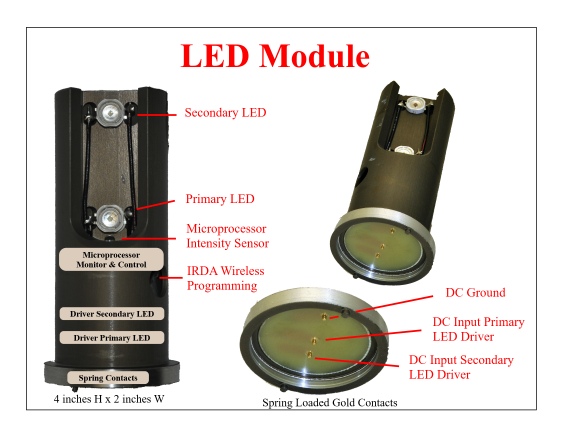HB (High Brightness) LEDs have undergone testing by LED manufactures who have determined that a LED will retain full intensity for a lifespan of 50,000 hours only when using constant current drivers and proper thermal management.
Furthermore, at 70,000 hours, the LED will have lost 30% of the original intensity even in a well-designed light.
The LED will gradually lose intensity, but the current will not be reduced.
A LED navigation light can lose intensity (not maintain requirements) before reaching 50,000 hours due to failure rates of electronic parts (MTBF), improper thermal management, thermal adhesives, and assembly.
UL 1104 and SOLAS LED navigation lights requirements:
Manufactures of UL 1104 LED navigation lights for SOLAS vessels are required to comply with the International Maritime Organization (IMO) Resolution MSC.253 (83) Performance Standards for Navigation Lights as stated in section 4.3 entitled Special requirements for lights using LEDs.
This resolution provides two choices: 1.) monitor intensity; or 2.) specify lifespan (count hours).
4.3
“The luminous intensity of LEDs gradually decreases while the electricity consumption remains unchanged. The rate of decrease of luminous intensity depends on the output of LEDs and temperatures of LEDs. To prevent shortage of luminous intensity of LEDs
.1 An alarm function should be activated to notify the Officer of the Watch that the luminous intensity of the light reduces below the level required by COLREGs;
or
.2 LEDs should only be used within the lifespan (practical term of validity) specified by the manufacturer to maintain the necessary luminous intensity of LEDs…”
Industry impact based on UL 1104 requirements:
It is inevitable that some LED navigation lights will fail, and there is no way to know which lights will last 50,000 hours at full intensity. Monitoring the LED intensity is the only way to ensure that the COLREGs nautical mile requirements are always maintained.
Most manufactures of UL 1104 navigation lights for SOLAS vessels have chosen (.2) in IMO resolution MSC 253(83) to count 50,000 hours of use and then require replacement of the light. During the 50,000 hours, there is no way of knowing if the lights are maintaining the intensity per COLREGs nautical mile requirements for SOLAS vessels over 165′ (50M).
Signal Mate has chosen to do both. Monitor the LED intensity to ensure the nautical mile requirements are always maintained as specified in (.1) in IMO resolution MSC 253(83). If the light intensity falls below the COLREGs nautical mile requirement, Signal Mate will turn off the current to the light, so the panel will trigger an alarm. Plus, count hours of use to indicate approaching end of life to schedule maintenance.
Inspected and SOLAS vessels:
Upgrading alarm panels for navigation lights from incandescent to LED: As the industry adapts from incandescent to LED navigation lights, two problems exists for inspected and SOLAS vessels that require alarm panels.
First, older alarm panels were designed to work with incandescent currents that are much higher than LED currents. Alarm panels for incandescent lights must be modified correctly to work with the lower currents of LED lights.
Secondly, with incandescent lights, if the light goes out, the current drops, and the alarm is triggered. When LEDs lose intensity there is no reduction in current; therefore, the alarm will not be triggered although the light is not the required intensity.
Signal Mate turns off the LED when the intensity falls below COLREGs. Therefore without current flow, the alarm panel will be triggered.
Proper navigation lights are critical equipment for all vessels, especially inspected vessels and vessels over 165′ (50M) that require certified UL 1104 LED navigation lights. Proper navigation lights are too important not to utilize the safest and most reliable lights available.

